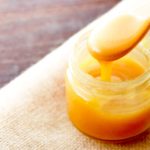 Whether drizzled on porridge, added to a green smoothie or eaten “neat” off a spoon, the health elite swear by Manuka honey to keep them fighting fit.
Whether drizzled on porridge, added to a green smoothie or eaten “neat” off a spoon, the health elite swear by Manuka honey to keep them fighting fit.
Originating in New Zealand, the antibacterial properties of the natural sweetener have been known for thousands of years.
Its distinctive taste comes from the wild Manuka tree, which bees forage on, collecting its pricey nectar.
With Waitrose charging up to £20.60 ($27.05) for a 225g jar, it has some pretty big health claims to live up to.
All honey is thought to be antibacterial to some extent due to it containing chemicals that release hydrogen peroxide.
This destroys bacteria’s cell walls and has been used as an antiseptic since the 1920s.
A 1991 study removed hydrogen peroxide from different types of honey, with only Manuka maintaining its bacterial-killing properties.
This was put down to its uniquely antibacterial ingredient methylglyoxal.
Off the back of this study, manufacturers added a Unique Manuka Factor (UMF) number to the honey pots’ labels.
A marker of potency, UMF roughly refers to how many bacteria the honey could destroy once the hydrogen peroxide is removed, the BBC reported.
Counterfeit products claiming to be Manuka honey lack a UMF number, which is only given to registered licensed beekeepers, producers and exporters of the genuine product, according to BBC Good Food.
Confusingly, some labels refer to methylglyoxal or “non-peroxide” activity, while others include the potentness of hydrogen peroxide when measuring Manuka honey’s anti-bacterial properties.
Prepare to pay for quality, with honey with a UMF accolade costing more.
The global demand for Manuka honey reportedly exceeds the supply, driving prices up, according to Open PR.
High demand has also created a “black market” of sorts, with some cheaper products being mixed with regular honey.
Is Manuka honey really good for you?
Yahoo UK previously reported on how Manuka honey “dressings” could ward off infections after an operation.
Newcastle University scientists alternated eight “nano layers” of medical-grade Manuka honey with polymers.
Manuka honey has a negative charge, while polymers are positive. Together, these created an “electrostatic nanocoating” that inhibited the growth of bacteria on surgical meshes.
While this may sound promising, the honey was medical grade and therefore had any impurities removed. This makes it distinctly different from the stuff available in the supermarket.
Many also swear by Manuka honey when they feel a cold or flu coming on.
With these exclusively being caused by viruses, the antibacterial properties of the expensive sweetener should in theory do nothing to combat the infections.
Scientists from Nagasaki University in Japan found, however, Manuka honey inhibited the reproduction of a flu virus in the laboratory.
A team from the University of Algarve in Portugal also noted Manuka honey was effective against the “chickenpox virus” when tested on human skin cancer cells.
Both Manuka and “ordinary” honey have also been shown to act against the herpes virus, with the latter also speeding up the healing of recurrent genital lesions caused by the infection.
Rather than forking out on the expensive sweetener, regular honey may be enough to calm an irritating cough.
Scientists from Shahid Sadoughi University in Israel gave 139 coughing children either 2.5ml of honey or the over-the-counter cough suppressants dextromethorphan and diphenhydramine.
Twenty-four hours later, those given honey saw their “cough frequency score” go down significantly more than the other youngsters’.
When it comes to Manuka’s “ace card”, there is little evidence methylglyoxal survives the gastrointestinal tract or benefits a person’s health when eaten, the BBC reported.
It is also important not to overindulge, with all honey containing around 5g of sugar per teaspoon, according to reference.com

